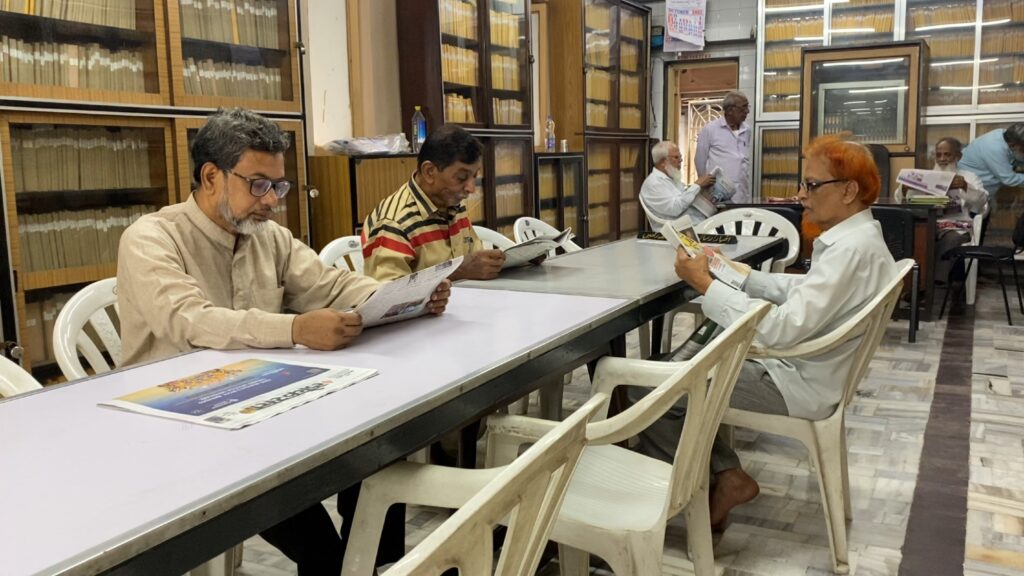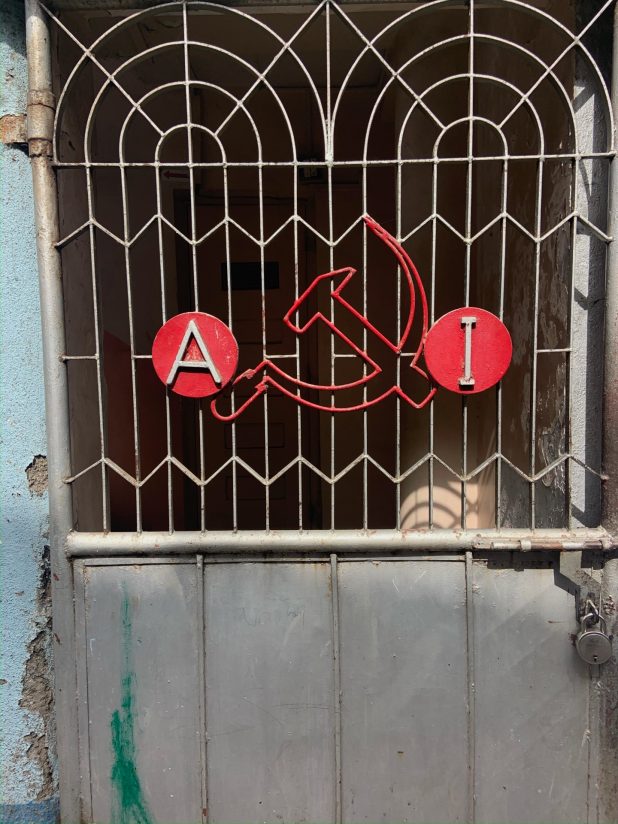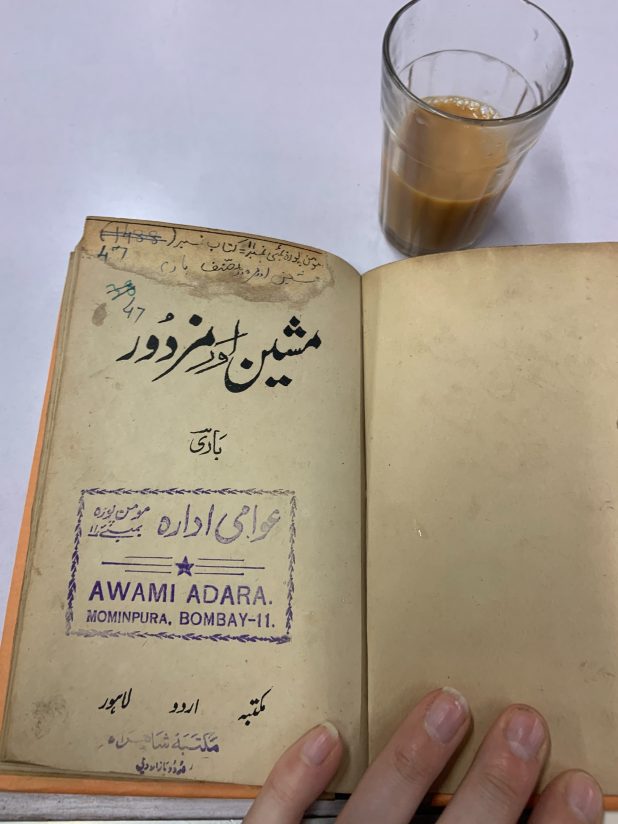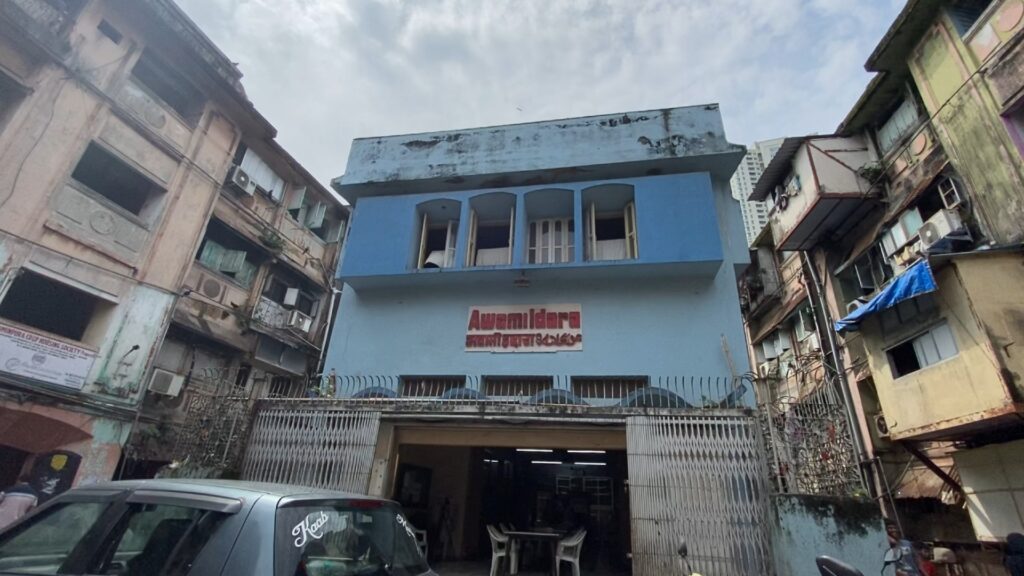Mumbai, MAHARASHTRA :

The Awami Idara, rooted in a working-class Muslim neighbourhood, connects the long history of Southasian Muslim labour activism to political movements and events across Mumbai, Southasia and beyond.
Upon entering the Awami Idara (People’s Institution) library in the summer of 2022, I first met the older members of the library peering over their newspapers. Having visited many other Urdu libraries dotted across India, I did not find the welcoming elderly newspaper readers surprising. More unusual, however, was a small but imposing bust of Vladimir Lenin perched above them all, and a hammer and sickle. The iconography reflected the library’s Marxist leanings, and its historical connections with the Soviet Union and transregional leftist movements. This history sharply distinguishes what is by reputation Mumbai’s largest Urdu library from many other Urdu collections in India.
Indeed, the distinctive mission and history of the Awami Idara are apparent from the moment one enters the library. Open from 6 to 10 pm, the library’s hours reflect its historically intended audience – labourers who worked at mills and factories during the day and read and gathered in the evenings. The library is located near the centre of a residential, working-class Muslim neighbourhood in Mominpura, Mumbai. Founded in 1952, it is surrounded by both homes and small-scale mills and factories, and seems designed not to impress visitors but to provide a welcoming, convivial space for local readers. While many readers visit the library to read newspapers or socialise, the walls are lined with thousands of Urdu books which, according to the library’s internal catalogue, are shelved in a strict numerical fashion and bound in uniform yellow covers.

In recent years, several newspaper and media reports have celebrated the unique and unusual nature of the Awami Idara, particularly the fact that a leftist library aimed at Muslim mill workers continues to survive and adapt in an era where right-wing Hindu nationalism flourishes. Others focus on the shifting religious ideologies evident in the surrounding neighbourhood, expressing surprise at the lack of conflict between Muslim movements claiming religious orthodoxy – most notably local proponents of the Ahl-i Hadith movement – and the left-leaning library. The fact that the largest and oldest Urdu library in Mumbai is a leftist organisation that once boasted strong ties with the USSR does sometimes seem incongruous in today’s political environment.
The Awami Idara is part of a long history of Southasian Muslim labour activism and an often-overlooked Indian Muslim left, rooted in the mills and factories of cities like Mumbai. The yellow-bound volumes lining the walls of the library hold wider histories, connecting the mill worker-readers of the Awami Idara to both local and transregional histories of the left.
Working-class readers
The Awami Idara and its collections force us to question our assumptions about how Muslim workers conceptualised their communities, neighborhoods and social and political connections. As the historian Arun Kumar argues, labourers’ efforts to avail themselves of night libraries – like the Awami Idara – and night schools in urban India from the early twentieth century more broadly belie our assumptions about labourers’ presumed illiteracy and lack of interest in education.
Many of the materials held by the Awami Idara – particularly those collected by the library in its early years, in the 1950s and 1960s – address readers as labourers, emphasising a reader’s identity as a mazdoor (worker). During my visits in May and June 2022, among the first texts to catch my eye was a volume titled Mashīn aur mazdoor (The machine and the worker). First published in 1941, and updated in 1946, it reflects regional debates about the role of the working class in the years immediately preceding independence and Partition, and its presence in the Awami Idara suggests the continued relevance of these debates in the post-Partition India of the 1950s.
” Founded in 1952, it is surrounded by both homes and small-scale mills and factories, and seems designed not to impress visitors but to provide a welcoming, convivial space for local readers.“
Published in Lahore, Mashīn aur mazdoor was authored by Abdul Bari Alig, often remembered today as an early mentor and teacher of Saadat Hasan Manto, and about whom Manto authored a notable biographical sketch. Bari was also the proprietor of several leftist newspapers in Punjab, and his writing ranged from a biography of Karl Marx and translation of his works to a history of Islamic civilisation and a treatise on the French Revolution, as well as a 450-page account of the rise of the British East India Company.
In Mashīn aur mazdoor, Bari suggests that workers might engage with “changing means of production” wrought by the industrial revolution and the rise of machines to shift the “distribution of power and ownership.” The text also highlights the contribution of Indian labour movements to the freedom struggle, and imagines new roles for Indian workers in the wake of British control. Bari maintaines that “socialism and communism are gaining ground in the political debates of India today. The working class of India is realising its political and economic importance.” For readers at the Awami Idara, the text suggests that labourers shaped the Indian past, and calls on them to exert political influence in a post-colonial, industrial and independent state.
The Awami Idara in historical context
Like many texts held in the Awami Idara, Bari’s Mashīn aur mazdoor suggested that Indian labourers sought to understand their own positionality in regional economic and political events and movements. Far from being illiterate or uneducated about their economic and social experiences, readers at the Awami Idara likely found, within the walls of the library, written polemics and debates that they used to make sense of their own experiences as both workers and political actors.
” Across the subcontinent, readers and writers from a wide range of religious communities continued to engage with Urdu.“
As a library and physical centre of workers’ intellectual culture, the Awami Idara was unique in Mumbai, and reflected the consolidating social influence of leftist organisations in the city’s working-class neighbourhoods in the 1950s. However, at the time of its founding, it was also part of a long tradition of working-class organisation in Mominpura and neighbouring areas around Byculla – such as Madanpura, Agripada and Nagapada – that stretched back to the late nineteenth century. The construction of textile mills in these neighbourhoods in the late nineteenth century drew in migrants both from elsewhere in Mumbai and across India, with Muslim workers developing extensive settlements around Byculla.
By the 1890s, textile mill workers in Byculla and surrounding neighbourhoods succeeded in organising and regularly shutting down mills to demand better wages and working conditions. Later, in the 1920s and 1930s, communist and socialist organisations in the city sought to provide formal sites for the education of workers in the neighbourhood. For instance, in 1934, the leftist Young Workers’ League of Mumbai rented a room in Byculla to serve as a labour centre in the area.

These many years of experience with labour agitation, organisation and strikes meant that readers in the neighbourhood already possessed forms of social and political connection to movements that connected them with other workers across Southasia. Key speeches, texts and arguments likely circulated within the new labour centres, the mills themselves and the workers’ neighbourhoods, long before the establishment of the Awami Idara library. In the primarily Muslim neighbourhoods that the library now serves, these leftist speeches, texts and arguments may have even circulated through some of the same networks and communities that served to sustain Islamic religious knowledge and practice.
Language and religion in the collections
Some texts held by the Awami Idara suggest readers’ interests in Islam and comparative religion. But most mid-twentieth-century Urdu texts held in the Awami Idara are more directly concerned with readers’ class and labour identities. For instance, in Mashīn aur mazdoor, Bari does not address his readers explicitly or exclusively as Muslims, although in other works he is interested in the forms of social organisation reflected in the Islamic past.
The plurality and religious diversity of Urdu writing held at the Awami Idara is not surprising. Over the course of the early twentieth century, some religious nationalist articulations had sought to distinguish the scripts of Hindustani by religious identity – associating Hindi, written in the devanagari script, with Hindus and Urdu, written in nastaliq, with Muslims. But this simplistic imagination contradicted the realities of Southasian readerships. Across the subcontinent, readers and writers from a wide range of religious communities continued to engage with Urdu. The authors of leftist Urdu texts framed their readers primarily as members of a shared class community, responsible for contributing to their fellow workers’ economic and political uplift.
That said, most of the readers at the Awami Idara were from Muslim backgrounds, though they likely differed in their degrees of religiosity (or lack thereof). The Muslim membership of the Awami Idara reflected the surrounding neighbourhood but was also indicative of an often-overlooked demographic reality of both pre and post-Partition urban India. In many of British India’s largest cities, Muslims made up a significant percentage of the industrial working class, and in several cases they formed the majority of regional migrants recruited to industrial mills in the early twentieth century.
Social solidarities in Muslim working-class neighbourhoods
This fact has often formed the basis of academic studies of “communalism” and conflict among mill labourers and other working-class communities. Scholars have sought to understand whether religious differences spurred labour solidarity and cohesion failures in industrialised Indian cities. But these debates have often overlooked how community institutions in working-class Muslim neighbourhoods contributed to labour movements, class-based identities and localised solidarities.
Popular imaginations of neighbourhoods and communities such as Mominpura have changed significantly over time. The academic Robert Rahman Raman has argued that, in Mumbai, there has been a significant shift over the course of the twentieth century in whether neighbourhoods are popularly seen as “working class” with primarily Muslim residents or “Muslim” with primarily working-class residents. Moreover, the anthropologist Thomas Blom Hansen has noted that, beginning from the 1960s, mill work and other forms of industrial labour in these neighbourhoods were reorganised, contributing to the marginalisation of Muslim labourers from the organised industrial economy. In the wake of the 1992-93 riots in Mumbai, many Muslims who lived elsewhere fled to Muslim-majority neighbourhoods such as Mominpura to escape violence.
As a result, areas that were historically considered labouring neighbourhoods have come to be known as “Muslim ghettos,” even in cases where their economic and religious demographics have not changed significantly. Despite these shifting external understandings and processes of ghettoisation, across the twentieth and twenty-first centuries, neighbourhoods like Mominpura have continuously provided a space for Muslim labourers to build local communities and debate their engagement with the broader political world.
Bringing the world to Mominpura
The Awami Idara also provided a space for members of these communities to debate and build an understanding of how their own experiences as labourers fit into global workers’ movements beyond the borders of Mumbai and the newly created nation-state of India. Another text that immediately caught my eye as I paged through the library’s extensive catalogue was a collection of the journal Naya Parcham (New Flag). Nayā Parcham was an Urdu periodical published in Mumbai in the late 1940s and early 1950s, around the same time as the foundation of the library. The journal was associated with the Progressive Writers’ Movement, and compiled by the prominent Urdu writers Rajinder Singh Bedi, Vishwamitter Adil, Muhammad Haider Asad and Zamir Niazi. While it served partially as a space for publishing the works of the Progressive Writers’ Movement, Nayā Parcham also focused on explaining the principles of socialism and Marxism to Urdu readers and keeping them apprised of global leftist movements.
” Popular imaginations of neighbourhoods and communities such as Mominpura have changed significantly over time.“
Issues of Nayā Parcham were donated to the Awami Idara in the 1950s by the city’s Nawjavan Party, which maintained offices nearby in neighbouring Mandapura. Like the editors of Nayā Parcham, the local leaders of the Nawjawan Party sought to reach Mumbai’s working-class communities, and to provide them with information about global leftist and working-class struggles.
One 1949 issue of Nayā Parcham held by the Awami Idara, for instance, was devoted entirely to the 1949 Chinese Revolution, with articles as well as lessons that Indians might take from the Chinese educational system. Opening with a “salaam” to “the New China,” the issue celebrated that “today the People’s Liberation Army of China covers one-third of China’s territory and leads more than half of its population.” The issue featured three Urdu translations of Chinese poems in praise of the revolution. This emphasis on global revolutionary poetry reflected efforts to reach Urdu readers – and potentially listeners – through literary language highlighting shared social and emotional experiences and desires.
A poem titled Chīn kī bahār (China’s Spring), pronounced:
“China’s spring is being rejuvenated on the battlefield
And this battlefield is uniting the entire world.”

Poems and articles celebrating the global success of leftist movements encouraged readers at the Awami Idara to understand their struggles as not bound by their neighbourhood, city or nation, but as part of a ‘battlefield uniting the entire world.’ The special issue on the Chinese Revolution reflected the global and transregional outlook of the publication and its intended readers. The experiences of the left across Southasia were of particular interest for Nayā Parcham. Published in the wake of Partition, the magazine especially focused on uniting the left across the newly created border.
It featured, for instance, regular dispatches and notes from Pakistan, addressing Indian readers as Southasian comrades, as shared participants in a class struggle that continued to unite readers across the newly established border. In June 1949, it included a letter from Ahmad Nadeem Qasmi, the secretary-general of the Progressive Writers’ Movement for Pakistan, who gained renown for his literary contributions over the subsequent decades. He addressed his article to “Friends! Comrades! And companions!” across the border.
” The Awami Idara also provided a space for members of these communities to debate and build an understanding of how their own experiences as labourers fit into global workers’ movements beyond the borders of Mumbai and the newly created nation-state of India. “
The letter was aimed in part at members of the Progressive Writers’ Movement in India, seeking to ensure continued exchange between the two wings of the movement, now divided by a border. But it also reflected Qasmi’s hopes for “lovers of progress” and leftist movements across the subcontinent, including workers’ movements. He admonished his readers not to forget the shared “yoke of colonialism” that had oppressed the subcontinent. Indeed, he argued that imperial influence, in the form of European capitalism, continued to contribute to the “suffering of all of our pride, our honour, our freedom.” Even across the border, he suggested, the struggle for progress could continue to unite the residents of the two new nations.
Texts like the Nayā Parcham provided working-class Muslim readers in Mumbai – who engaged with these writings throughout the 1950s and even later – connection to larger communities and struggles. They suggested that fights for progress and the rights of workers were not divided by borders within Southasia or beyond it or limited to specific urban localities. By collecting and making these texts accessible, the Awami Idara encouraged readers in Mominpura to participate in workers’ movements that would contribute not only to their own uplift, but also to shared Southasian and global progress.
Plural interests
Not all the materials held in the Awami Idara offer an explicitly leftist point of view or focus primarily on the experiences and political aims of the working class. On the contrary, the library’s early collections suggest that mid-twentieth century Muslim mill workers possessed many interests. In addition to finding magazines, books and newspapers that situated them within global working-class struggles, mill workers also used the library to read everything from novels to travelogues, religious treatises to poetry collections. While the founders and supporters of the library aimed to educate mill workers through leftist publications, they also recognised the demand for a wide range of literature among Mumbai’s working-class Muslim readers.
Published in the wake of Partition, Nayā Parcham especially focused on uniting the left across the newly created border.
Other materials also focused on the needs and interests of labourers, but from a technological perspective rather than an economic-political perspective. Indeed, I was first drawn to the library through my efforts to trace the development of Urdu-language technical manuals and treatises, in trades ranging from papermaking to metal plating. The library boasts several such manuals, reflecting the efforts of workers to expand their knowledge of their trades and perhaps move up in factory or workshop hierarchies. Whether or not texts were aimed primarily at workers, throughout the second half of the twentieth century the library collected printed Urdu materials from across India and Pakistan. In doing so, it built an eclectic collection that also tied its Mumbai neighbourhood to trans-Southasian worlds of Urdu literature and writing.
The Awami Idara and its collections offer an important reminder that people – including working-class people – hold multiple political, social and religious identities simultaneously. The books and journals held at the library demonstrate that Muslim labourers in Mumbai were aware of Southasian and broader global political currents, and sought to understand their place within them. While rooted in a highly local space – a unique library and its walls of bound volumes in Mominpura – the Awami Idara provided a space for Mumbai’s Muslim labourers to consider their connections and commitments to political movements and events across Mumbai, Southasia and beyond.
source: http://www.himalmag.com / Himal, South Asian / Home> Culture> Essay> India / by Amanda Lanzillo / January 09th, 2023








